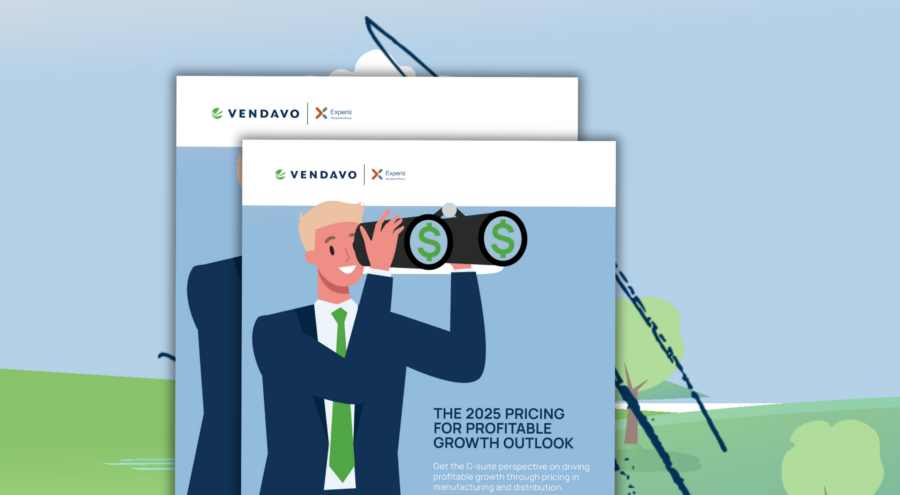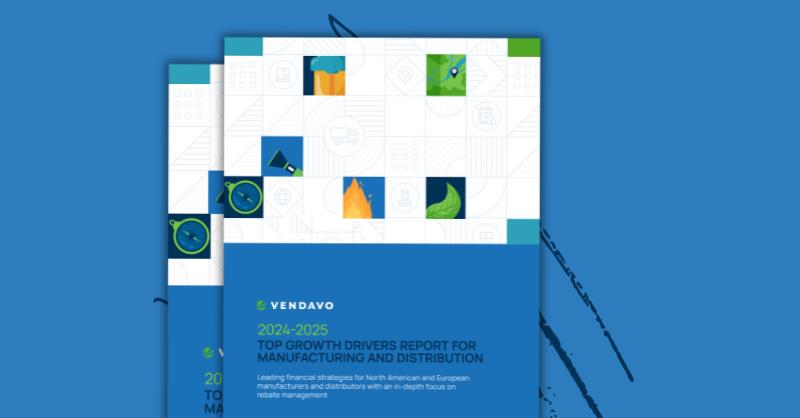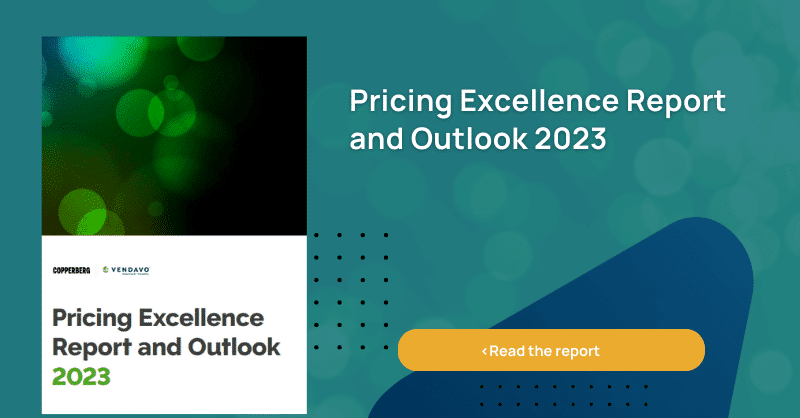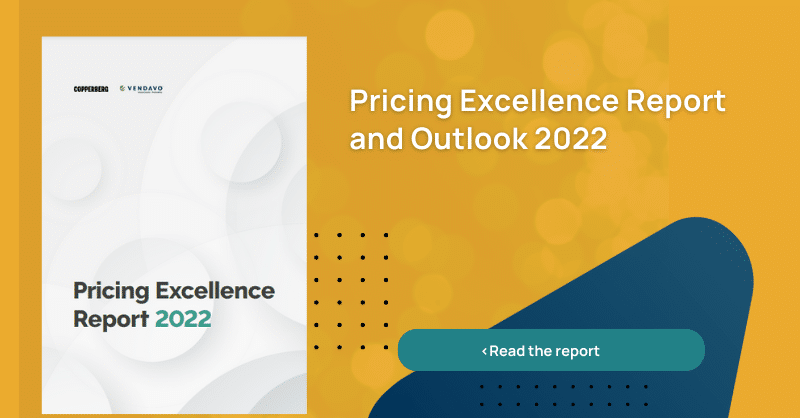
Pricing Excellence Research
Get ahead in your industry with Vendavo’s original research. This report hub is the culmination of years of intensive research surveying the industry’s top pricing professionals, revealing the game-changers that are shaping pricing excellence.
Growth and Profitability Research
Key Findings
Analytics, price management, understanding the concept of value, strategic thinking, and business acumen continue to be the most sought-after pricing skills. (2024)
The value-based model (28%) continues to be the top choice for organizations, but it is closely followed by cost-plus and market-based methodologies. (2024)
The top five challenges identified by respondents are competitive pressures, pricing processes, market turbulence, their own technology solutions, and customer expectations. (2024)
Additional Research
Aftermarket Reports
An often underestimated skill in pricing is the ability to sell the data’s reality. It’s not enough for pricers or analysts to understand the market truth themselves. Pricers must also make an effort to help their colleagues in sales, marketing, and finance recognize the need for attitude or activity change. Translating X, Y, and Z into a compelling and human call for action is critical. And that skill is sometimes absent in even the most data-focused pricers or analysts.
Chris Kennedy-Sloane
Business Consultant, Vendavo
The most successful pricing leaders were not only agile but were forward-looking. Agility in pricing was driven out of our necessity to envision a “new way” of doing things. This skillset to execute will remain key. Although inflationary pressures and disruption to global supply chain will decrease over time, your competition will not. Agility will take the form of data collection and deeper comprehension of your customers and their buying patterns. AI will help, but only if you are already tracking the data to be consumed. Begin tracking any data point in a transaction, no matter how small. Future agility will be defined on our ability to enact on data points quickly.
Elvin McLaughlin
Senior Director of North American Implementations, Vendavo
The pandemic was hopefully a once-in-a generation type of disruption, but we all know if you could predict disruption you’d be rich and retired. Your duty as a steward of a business is to be prepared for whatever the world throws at you. In that sense, agility should remain a key focus as it is perpetually needed to manage your business well.
David Anderson
Vice President of Business Consulting, Vendavo
I believe in harnessing the power of collaboration through a regular 30-minute weekly cross-functional meeting. It may seem like just another meeting, but when run efficiently by the pricing team, it becomes a vital pricing review and decision session. Our simple agenda includes presenting analytical reports, gathering market feedback from the sales team, receiving inputs on ongoing marketing campaigns from finance and marketing, and collectively deciding on pricing changes. Turning meetings into valuable moments is key to any organization’s success.
Janice Shih
Principal Consultant, Vendavo
It is imperative that any pricing leader be inclusive with stakeholders in their efforts. This means focusing on understanding needs, clearly communicating value, and gaining buy-in from sales, marketing, finance, product, and other stakeholders in the organization. Any pricing leader needs to be skilled and focused on the political aspect of pricing improvement.
David Anderson
Vice President of Business Consulting, Vendavo
At Vendavo, we empower companies to unlock the true value of pricing management. Our Margin Bridge Analyzer enables organizations to quantify the impact of our solutions on their business, leveraging over 20 years of experience in driving top-line and bottom-line performance improvements. Additionally, our dedicated Value Acceleration team ensures that our customers maximize their investment, providing expert guidance to extract the utmost value from our pricing solutions.
Mitchell Lee
Profit Evangelist, Vendavo
To tackle shared challenges, management must make prompt and informed decisions. Agile, configurable business system solutions are essential for efficient strategy execution. Organizations require tools to identify revenue and margin growth opportunities and gain a comprehensive view of the impact over time. Vendavo offers cost-effective solutions that deliver quick ROI, enabling management to thrive in today’s rapidly evolving business environment.
Mike Slavin
Business Consultant, Vendavo
While self-learning algorithms and language processing models show promise, unexpected outcomes can arise. Human controls remain crucial. Once ready, pricing will be driven by value, eliminating guesswork as seen in algorithmic trading.
Chris Kennedy-Sloane
Business Consultant, Vendavo
In times of uncertainty, companies face critical choices. A heightened focus on existing customer relationships is one route you can take to maintain profitability.
Mike Bernard
Chief Marketing Officer, Vendavo
In uncertainty, prioritizing value-added services, upgrades, and parts secures revenue and customer loyalty. Acquiring new customers costs five times more than keeping existing ones. ‘Locking in’ customers through agreements strengthens market position.
Chris Kennedy-Sloane
Business Consultant, Vendavo
Reactive modes are very common in the aftermarket, so do not panic, you are not alone! When you’re in a reactive mode, that is usually an indicator of overall service business maturity. You can create more proactive services by improving the services maturity. Is there a clear responsibility for your service business? Are the right resources in place to support your customers?
Kalle Aerikkala
Senior Business Consultant, Vendavo
Investment in e-commerce and supporting digital solutions can no longer be slow-walked. Critically, companies found success with partial plans and did not let perfect stand in the way of progress. If you’re considering a digital transformation, just get started. Do not attempt to boil the ocean and solve everything at once. Find manageable areas to make small improvements. Collect wins, socialize them within the rest of the company, and find the next area to work on.
Dan Cakora
Business Consultant, Vendavo
Organizational agility is one of the key success factors in aftermarket business. One excellent method to foster this culture is through clear responsibilities. Aftermarket organizations are usually organized around functions such as sales, sourcing etc. I recommend every organization run Price-Volume-Mix analysis where each element, like volume, or cost development is owned by the suitable function. This keeps the whole organization working together and ready to pivot when needed.
Kalle Aerikkala
Senior Business Consultant, Vendavo
Organizations need to be able to react quickly and make timely price changes. Ensure your price changes are based on commercial intent. Remember what goes around comes around. Over aggressive price increases can lead to longer term customer attrition. Focus on your high value customers and work in partnership with them to ensure they understand your reasons for price adjustments.
Robert Irwin
Senior Vice President of Business Consulting, Vendavo
Don’t let perfection be the enemy of progress. Nobody has perfectly clean data, but there’s a wealth of insights for fixing what’s broken – and promoting what’s working – even if all you have is dirty data. Get started with a foundation that can deliver quick wins, and you’ll get support for improving data readiness in areas that will add value to the business. And for progressively adding new capabilities that drive better business decisions. It’s a positive-feedback control loop – so even a rough measurement can initiate the momentum in the right direction.
Mitchell Lee
Profit Evangelist, Vendavo
Planning for long-term Aftermarket success should follow a set of best practices that build digital capabilities relevant in any market condition. Gain control over pricing through oversight, coordination and increased authority of the pricing team. Optimize margin by reevaluating segmentation methods, identify pricing levers. Secure C-suite support to raise organizational confidence in price-setting decisions. Finally, establish central leadership and build a center for commercial excellence.
Robert Irwin
Senior Vice President of Business Consulting, Vendavo
Measure twice, cut once. Use analytics to provide line-of-sight to what is actually happening. Frequent internal communication is key to building alignment on crafting a plan. A plan without action is just a dream, so execution is the critical ingredient in enhancing profitability.
Dan Cakora
Business Consultant, Vendavo
Finding workers that are business savvy and have strong data skills is getting harder. Start with finding people that are curious, energetic, and work well with others. Help them learn the skills you need and give them opportunities to gain savvy by putting them into play as soon as possible. You’ll help them build themselves and they’ll help you build your business. Yes, some will learn and leave, but they’re going to be a promoter of you and your organization, rather than a detractor. It’s a small world. That investment will pay off somehow, some way, most likely when you least expect it.
Mitchell Lee
Profit Evangelist, Vendavo
Adaptability is the combination of preparation and mindset. Companies need to invest in solutions that will allow them to pivot with agility as the market changes. More importantly, a culture that supports proactive decision-making while taking reasonable risks will empower employees to lean into growth for the company.
Dan Cakora
Business Consultant, Vendavo



















